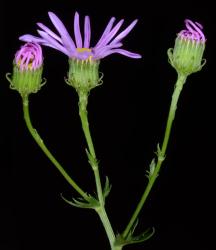- Taxon
- Weed
- Gallery
Erect, glabrous, perennial herb, becoming distinctly woody toward base, up to c. 1 m tall. Stems branched above to form infl. and branched below in older plants. Lvs apetiolate, not lobed, ± oblong or narrow-elliptic to obovate-elliptic, serrate, acute, amplexicaul and often coarsely toothed at base, usually somewhat decurrent, 3–8–(11) × 1–2.5–(3.5) cm; venation pinnate. Upper cauline lvs becoming smaller, ovate-oblong or lanceolate, and less distinctly toothed except at base. Capitula many, in loose corymbs. Supplementary bracts (13)–16–23, lanceolate to subulate, 3–5.5 mm long. Involucral bracts 19–23, narrow-oblong to linear, 6–9 mm long. Ray florets 12–22; ligules purple, mauve-pink or pale to deep pink, (10)–12–25 mm long. Disc yellow. Achenes terete, c. 2.5 mm long, those of ray florets glabrous, those of disc florets hairy; pappus 7–9 mm long.
[From: Webb et al. (1988) Flora of New Zealand. Volume 4.]
Flowering: Sep.–Nov.




